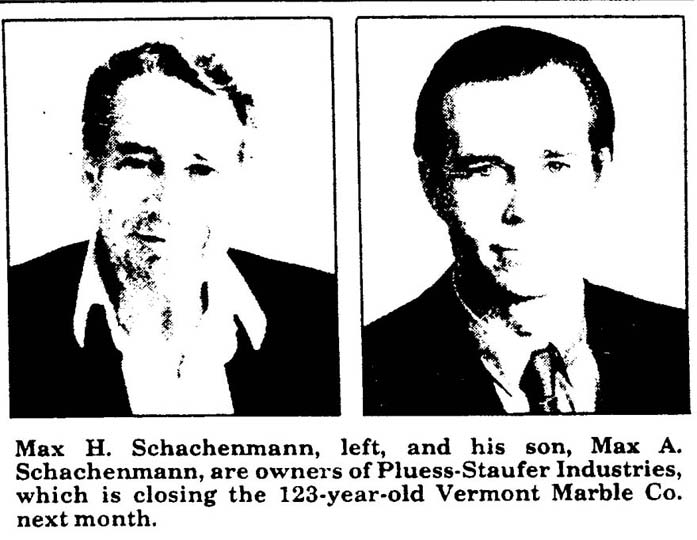January 28, 1993
Proud Marble Soon Memory
Swiss Company Closing Longtime Proctor Plant
By Bruce Edwards
Proctor – Vermont Marble Co., once supplier to some of the world’s great buildings and employer of thousands, will close next month ending 123 years as a strong economic and political force.
Pluess-Staufer Industries, the Swiss owners of Vermont Marble, announced Wednesday that it would close its Proctor mill at the end of February and sell its two remaining quarries in Rochester and Isle LaMotte. Approximately 15 workers will lose their jobs when the mill closes.
In a two-page statement, the company blamed the closing on the recession and the inability of the company to obtain what it called "a reasonable" water discharge permit from the state to operate the company’s settling ponds.
The Vermont Marble exhibit and the company’s power division, which supplies electricity to the town of Proctor, were not affected, the company said.
"We are saddened to close this 123-year old business, but we see no end to the building industry recession," company president John M. Mitchell, said in the press statement.
Reached at his Danby home Wednesday night, Mitchell said "given the economic realities the company was left with no viable option" but to close the mill.
"The company hopes it will be able to sell the mill for use by another industrial customer," said Mitchell. He declined to say whether there were any potential buyers.
The closing of Vermont Marble had been feared for several months as reports circulated that Pluess-Staufer was actively attempting to sell the marble company.
A deal that would have sold the company to Gawet Marble & Granite Co. of Center Rutland fell through in November. After the Gawet deal collapsed, Pluess-Staufer entered into a long-term agreement this month to lease its famous Danby quarry – the company’s largest and most valuable asset – to a European stone conglomerate headed by R.E.D. Graniti of Italy.
Those familiar with the company and the marble industry had speculated that without its Danby quarry it would be just a matter of time before Pluess-Staufer closed Vermont Marble.
However, earlier this month a Vermont Marble official indicated there was no immediate plan to close the plant. Vermont Marble spokesman Robert Condon said the company had stockpiled enough marble to meet its contract obligations and, if needed, could buy additional marble from the new operators of the Danby quarry.
Condon said at the time that the marble business had been in decline, and he would not comment on the long-term future of the plant. He also said that Pluess-Staufer had been interested in selling the marble company since shortly after it was purchased in 1976.
In addition to leasing its Danby quarry, the company is on the verge of selling its Rochester quarry to Marble Modes of Queens, N.Y. The Rochester quarry is the source of Verde Antique, a dark green marble.
No buyer has been identified for the Isle LaMotte quarry, the source of Champlain Black marble.
Attempts to reach state officials about the company’s allegation that it could not obtain a "reasonable" water discharge permit were unsuccessful.
Wastewater used in the marble manufacturing process has been pumped from the mill to a series of holding ponds where the marble dust is allowed to settle before being put back into the Otter Creek.
According to Mitchell, by the time the water reaches the Otter Creek from the holding ponds a half-mile away, 98 percent of the marble dust has been removed.
However, he said a new discharge permit requires the company to remove the turbidity and alkalinity before the water even leaves the holding ponds. Mitchell said the permit, which is under appeal to the Water Resources Board, would require an investment in the six-figure range.
But Mitchell readily acknowledged the worldwide recession played a large part in the decision to shut down the company. He said only governments were using marble in the construction of buildings and the market was very competitive.
The closing of Vermont Marble marks the end of a company that during its heydey was a major political and economic force in the state. Founded by Col. Redfield Proctor in 1870, the company at one time employed several thousand workers and provided marble for some well-known buildings.
Proctor and his family were a dominant political force in the state. Four Proctors served as Vermont governor over the years. But their political might waned along with the demise of the marble industry.
Pluess-Staufer Industries is the U.S. subsidiary of Pluess-Staufer AG of Oftringen, Switzerland.
The company bought Vermont Marble in 1976 from the Proctor family trusts and about 90 stockholders for between $7 and $10 million. The Swiss company’s primary interest in acquiring Vermont Marble was to gain a foothold in the U.S. for its primary business, which is calcium carbonate – the crushed marble, limestone and chalk that is used in the paper, paint and plastics industries.
In addition to its dimension stone quarries, Vermont Marble had an interest in White Pigment, a calcium carbonate operation in Florence, and owned quarries in the Brandon and Middlebury area that supplied marble to the Florence plant.
Founded in 1884, Pluess-Staufer is a multinational company that operates calcium carbonates facilities in 15 countries. In addition, the company is involved in the chemicals and pharmaceuticals trading business. At the end of 1990, the company employed 3,454 people worldwide.
The company reported sales from its international operations of more than $1.35 billion in 1991. But those sales generated a profit of only $8 million. The modest profit is based on sales for Pluess-Staufer, AG, the parent company and apparently does not include profits from its several subsidiaries.
The company is owned by Max H. Schachenmann and his family, one of the world’s wealthiest families. In 1989 and 1990, Schachenmann made Fortune magazine’s list with a net worth of $1 billion.
